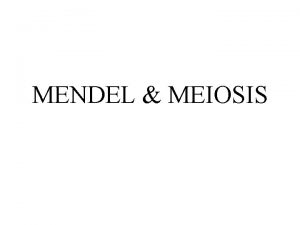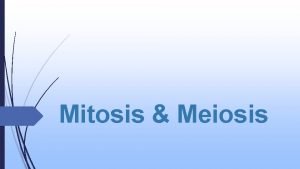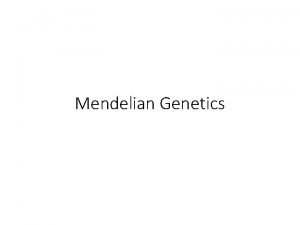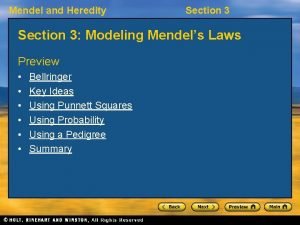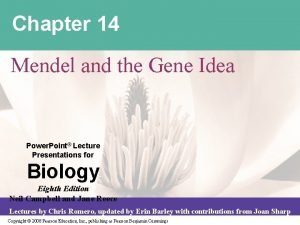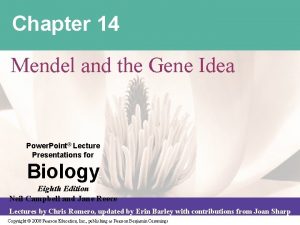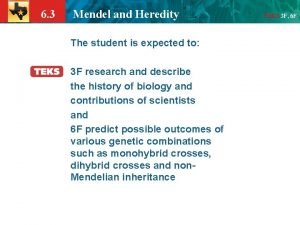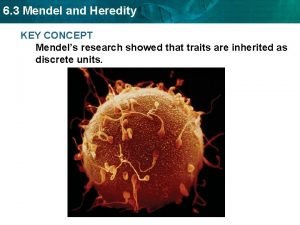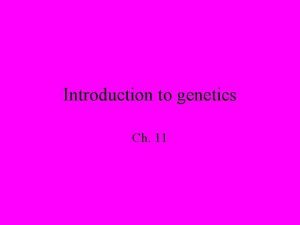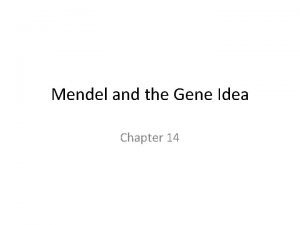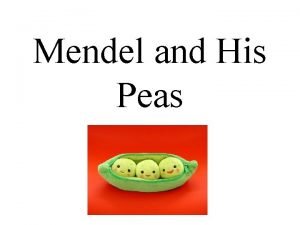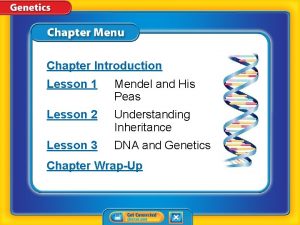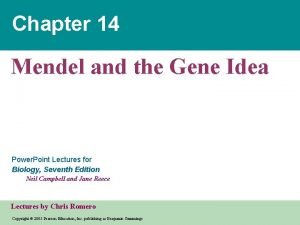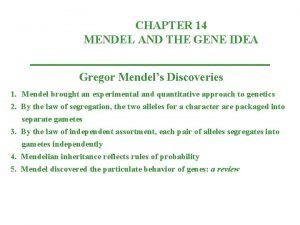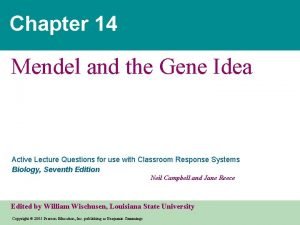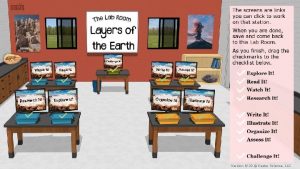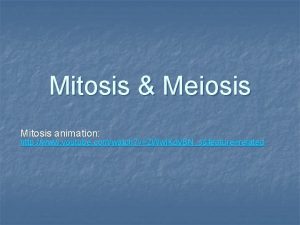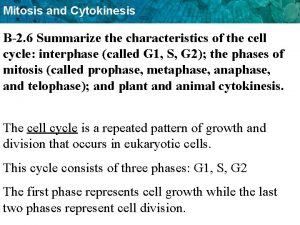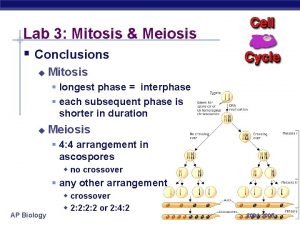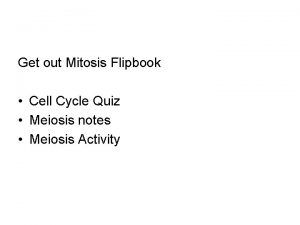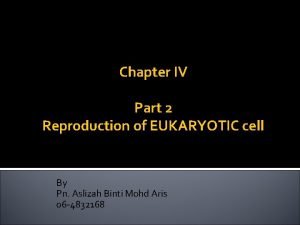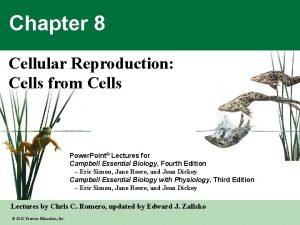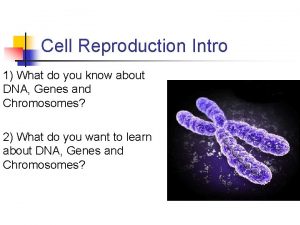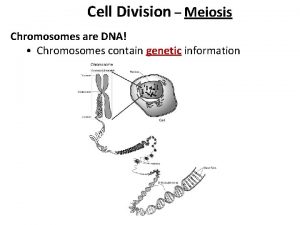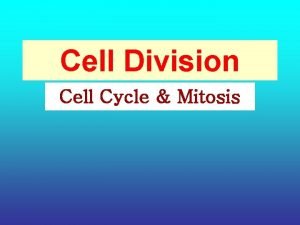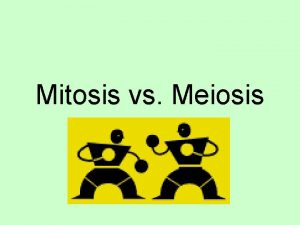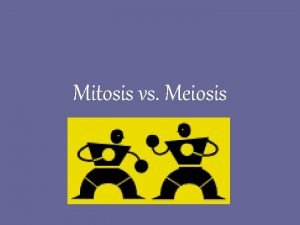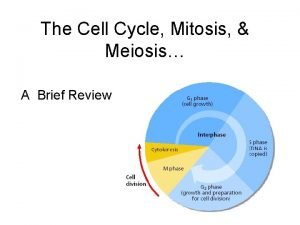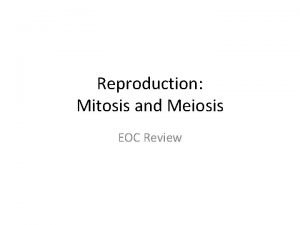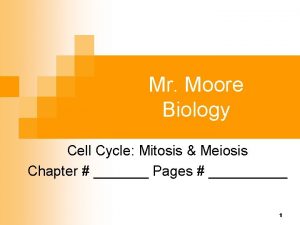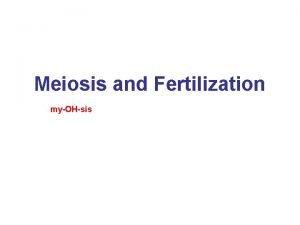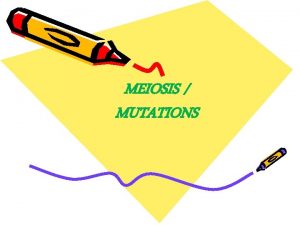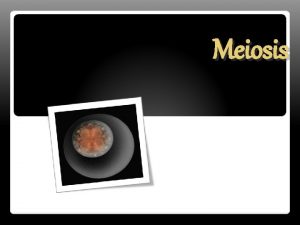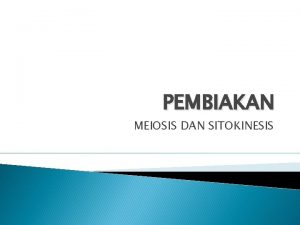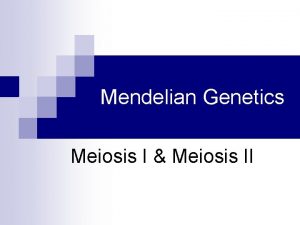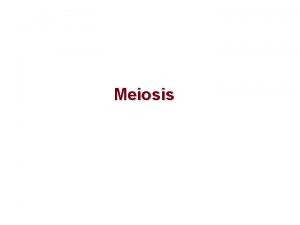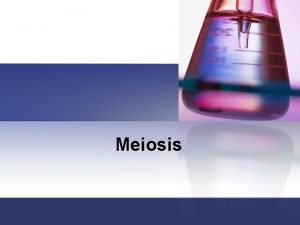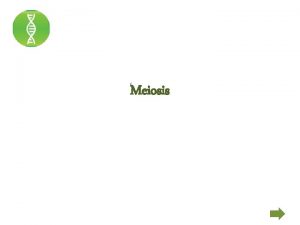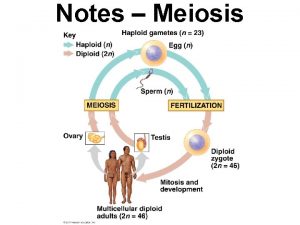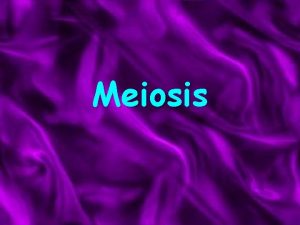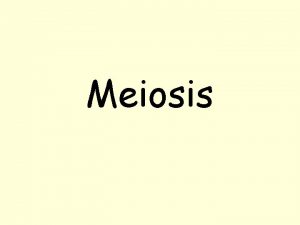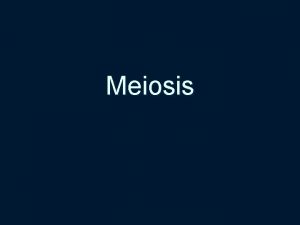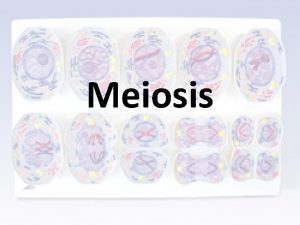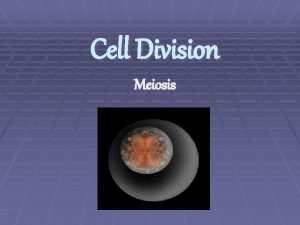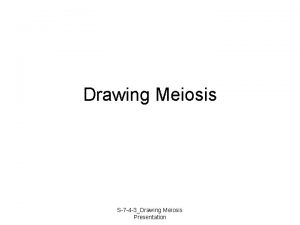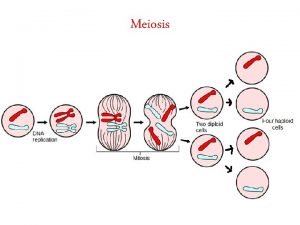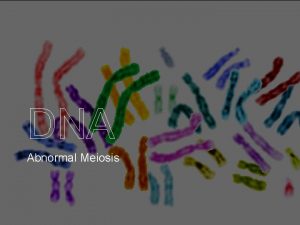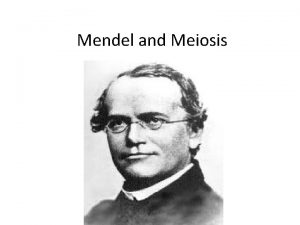Slide 1 Mendel and Meiosis Slide 2 Mendel





























































- Slides: 61

Slide 1 Mendel and Meiosis

Slide 2 Mendel: An Austrian Monk n Why offspring resemble their parents? n Pea plants to study inheritance of characteristics. n Traits transferred.

Slide 3 Genetic Terms n Heredity: The passing of characteristics from parents to offspring. n Genetics: Branch of biology that studies heredity. n Traits: Characteristics that are inherited. n Gametes: Sex Cells (two distinct cells –male and female)

Slide 4 Plant Fertilization n Male gamete is pollen (produced by anther) n Female gamete is ovule (produced in the pistil) n Pollination: The transfer of male pollen grains to the pistil of a flower. n Fertilization: The uniting of male and female gametes. Occurs when male gamete in the pollen grain meets and fuses with the female gamete in the ovule. n After the ovule gamete is fertilized, it matures into a seed.

Slide 5 Genetics Terms n Hybrid- Offspring of crosses between parents with different traits n Purebred- Organisms that carry only one variation of a characteristic.

Slide 6 Mendel’s Experiment: Why Pea Plants? Reproduce sexually (sex cells) Male and female gametes are in same flower Reproductive parts are enclosed tightly together. Reproduce by self-pollination (Male and Female coming from same plant) n Mendel could manipulate n n n Cross-Pollination: Breed-or-cross, one plant with another – Mendel opened petals and removed anthers – Dusted the pistil with pollen from plant he wanted to cross with – Covered with bag

Slide 7 Mendel a careful researcher n Controlled experiments and peas n One trait at a time n Analyzed data mathematically n Used plants that were tall for many generations (true breeding for tallness). Used plants that were short for many generations (true breeding for shortness. )

Slide 8 Mendel’s Monohybrid Cross: Mendel crossed tall and short plants to produce new plants. n Hybrids: Offspring of parents that have different forms of a trait. (short and tall). n Mono (one): n 1 st experiments monohybrids n Each parent plants differed by one single trait (height).

Slide 9 Mendel’s Monohybrid Cross n (P 1=“parents”) – Short pea plant x Tall pea plant first generation (F 1=“filial”) Result: All tall pea plants n F 1(first generation) Self-pollinate – Tall pea plant x Tall pea plant – 3/4 th’s Tall – 1/4 th Short n F 2(second generation)

Slide 10 Crosses P 1 generation—original parents “P” parent n F 1 generation—Offspring of parents “F” filial—son or daughter n F 2 generation—Cross 2 from F 1 generation. n

Slide 11 Trait patterns Mendel Observed In every case, he found that one trait of a pair seemed to disappear in the F 1 generation, only to reappear unchanged in ¼ of the F 2 plants.

Slide 12 Role of Unit factors n Two factors control each traits n Genes located on chromosomes. n Different forms of genes are called ALLELES. Example: Alleles for height Two alleles for tallness Two alleles for shortness One allele for tallness and one for shortness n Alleles are located on different copies of the chromosomes

Slide 13 The Rule of Dominance n Dominant trait: Observed trait – Masks recessive (Example: Mendel’s F 1—All tall plants/tall allele is dominant trait) n Recessive trait: Trait hidden by dominant trait (Example: Mendel’s F 1—All tall plants/short allele that reappears in F 2 is recessive trait)

Slide 14 Allele Shorthand – Same letter for different alleles – Upper case for dominant allele – Lower case for recessive allele – Dominant written first Example: Allele for tallness = T Allele for shortness = t Tt

Slide 15 Law of Segregation (Mendelian) Each organism has two different alleles, it can produce two different types of gametes. During fertilization, male and female gametes randomly pair to produce four combinations of alleles.

Slide 16 Phenotype n Greek words phainein, meaning “to show, ” and typos, meaning “model. ” n The visible characteristics (appearance and behavior) of an organism makes up it phenotype. n Example: Round, Wrinkled Yellow, Green Brunette, Blonde Blue Eyes, Brown Eyes

Slide 17 Genotype n From the Greek words gen or geno, meaning “race, ” and typos, meaning “model. ” n The genetic characteristics of an organism make up its genotype. Example: Genotype of a tall plant that has two alleles for tallness is TT. Genotype of a tall plant that has one allele for tallness and one allele for shortness is Tt.

Slide 18 Homozygous Trait for two alleles is the same Example: Two alleles for tallness (TT) homozygous dominant Two alleles for shortness (tt)— homozygous recessive.

Slide 19 Heterozygous Two different alleles for one trait. Tt

Slide 20 Punnett Squares. n (1905) Reginald Punnett, an English biologist, created way to expected proportions of possible genotypes in the offspring of cross-Punnett Square. n Know the genotypes of the parents, you can use a Punnett square to predict the possible genotypes of their offspring.

Slide 21 Making a Punnett Square

Slide 22 Monohybrid Crosses n Mendel’s cross Tt x Tt n Half the gametes of each parent would contain the T allele, and the other half would contain the t allele. Gametes that each parent forms One parent It doesn’t matter which Tt x Tt set of gametes are on top Other Parent and which are on the side.

Slide 23 Determining Phenotypes (characteristics) n If organism has at least one dominant allele, dominant trait will be expressed. (TT, BB, Tt, Bb ) n For the recessive trait to be expressed, organism must lack dominant allele and have two recessive alleles. (bb or tt) n Of the offspring ¼ will be homozygous dominant (TT/BB) 2/4 or ½ will be heterozygous (Tt, t. T, Bb, b. B) and ¼ will be homozygous recessive.

Slide 24 Mendel’s Dihybrid Crosses Di means “two. ” n Dihybrid cross: A cross involving two different traits. n Mendel did true-breed dihybrid cross between round yellow seeds (RRYY) and wrinkled green seeds (rryy) n Mendel’s results of dihybrid cross: n – – – P 1 round yellow x wrinkled green F 1 All round yellow (round yellow dominant) F 2 9 round yellow, 3 round green, 3 wrinkled yellow, 1 wrinkled green. Mendel found 2 dominate traits for round and yellow seeds.

Slide 25 Mendel’s dihybrid cross Dihybrid cross led to Mendel’s Law of Independent Assortment.

Slide 26 Dihybrid Crosses n Think of the RRYY x rryy cross (Round Yellow x Wrinkle Green seeds) n Mendel found that seed shape and seed color would be inherited independently of each other. n Punnett square you will need four boxes on each side.

Slide 27 Dihybrid Cross

Slide 28 Law of Independent Assortment Mendelian principle stating that genes for different traits are inherited independently of each other. Example: Genotype Rr. Yy produces gametes: Rr will separate Yy will separate Recombine in 4 different ways.

Slide 29 Dihybrid Cross Punnett squares are good for showing all the possible combinations of gametes and the likelihood that each will occur. However, you don’t get the exact ratio of results shown in the square.

Slide 30 Probability n Genetics follows the rules of chance. n Probability or chance that an event will occur can be determined by dividing the number of desired outcomes by the total number of possible outcomes. desired # of outcomes / total # of possible outcomes (Example: Toss a coin the probability of getting heads would be one in two chances, written 1: 2 or ½. n A Punnetts square can be used to determine the probability of the event.

Slide 31 Probability

Slide 32 Meiosis

Slide 33 Genes Tens of thousands of genes n Lined up on chromosomes n

Slide 34 Chromosomes n Occur in pairs (Male, n DIPLOID—A cell with two of each kind of chromosome is said to be diploid, or 2 n, number of chromosomes Female)

Slide 35

Slide 36 Gametes n Male (sperm) and Female (egg) n Contain one of each kind of chromosomes. n A cell with one of each kind of chromosome is called a HAPLOID and is said to contain a haploid, or n, number of chromosomes.

Slide 37

Slide 38 Chromosome Numbers of Some Common Organisms Organism Fruit Fly Garden Pea Corn Tomato Leopard Frog Apple Human Chimpanzee Dog Adder’s tongue fern Body Cell (2 n) 8 14 20 24 26 34 46 48 78 1260 Gamete (n) 4 7 10 12 13 17 23 24 39 630

Slide 39 Homologous Chromosomes Pair chromosomes are called homologous chromosomes— determine phenotype. n Gene for same trait n – same order, – chromosomes in a homologous pair are not always identical. n (Chromosome 4 contains 3 traits Mendel Studied)

Slide 40

Slide 41 Meiosis From the Greek word meioun, meaning “to diminish”. Cell division that results in a gamete containing half the number of chromosomes of its parents.

Slide 42 n n n Meiosis Divisions: Meiosis I and Meiosis II Begins with one diploid (2 n) cell four haploid (n) cells. Sex cells (gametes) haploid. Sperm fertilizes an egg-results in zygote (diploid) Zygote develops by MITOSIS into a multi-cellular organism. Reproduction —Production and subsequent fusion of haploid sex cells.

Slide 43 Interphase Chromosomes replicate n Chromosome n – two identical sister chromatids held together by a centromere

Slide 44 Prophase I Chromosomes coil up and a spindle forms. n Homologous chromosomes comes together, matched gene by gene, to form a four -part structure called a tetrad. n Chromatid pair so tight that sometimes non-sister chromatids from homologous chromosomes sometimes exchange genetic material in a process known as n crossing over.

Slide 45 Crossing Over Exchange of genetic material n Any location n Several locations at once n Humans-Two to three crossovers for each pair of homologous chromosomes. n

Slide 46 Metaphase I Centromere attaches to a spindle fiber n Spindle fibers pull the tetrads into the middle, or equator, of the spindle. n Chromosomes are lined up side by side as tetrads. n

Slide 47 Anaphase I Chromosomes separate and move to opposite ends of the cell. n Centromeres holding the sister chromatids together do not split like they do in anaphase of mitosis. n Ensures that each new cell have only one chromosome from each homologous pair. n

Slide 48 Telophase I n n n Spindle is broken down Chromosomes uncoil Cytoplasm divides 2 new cells. Half of genetic information of original cell (one chromosome from each homologous pair) Another cell division needed

Slide 49 Meiosis II n n n Newly formed cells go through short interphase (chromosomes don’t replicate) Prophase II—Spindle forms in each of the two new cells and the spindle fibers attach to the chromosomes. Metaphase II—The chromosomes, still made up of sister chromatids, are pulled to the center of the cell and line up randomly at the equator. Anaphase II—Centromere of each chromosome splits, allowing sister chromatids to separate and move to opposite poles. Telophase II—Nuclei reform, spindles break down, and cytoplasm divides.

Slide 50

Slide 51 Meiosis Results n Four haploid sex cells have been formed from one original diploid cell. n Each haploid cell contains one chromosome from each homologous pair. n Haploid cells become gametes, transmitting the genes they contain to offspring.

Slide 52

Slide 53

Slide 54 Genetic Recombination Gene combinations vary based on how chromosomes lines up during metaphase I (random). n As number of chromosome increase the number of gene combinations increase. n Example: Pea Plants (7 n) 27= 128 x 128 =16, 384 different offspring Sperm Egg Human (23 n) 223= 8 million x 8 million =70 trillion possible zygotes. Reassortment of chromosomes and the genetic information they carry, either by crossing over or by independent segregation of homologous chromosomes is called GENETIC RECOMBINATION. n Provides genetic variation n

Slide 55

Slide 56

Slide 57 Mistakes in Meiosis n Nondisjunction (failure of homologous chromosomes to separate) results in gametes with either an extra chromosome or a missing chromosome. n Extra chromosomes often survive; those lacking one or more usually do not. n TRISOMY—Extra Chromosome e. g. —Extra chromosome 21—Down’s Syndrome

Slide 58 Mistakes in Meiosis Continued… n MONOSOMY—When a gamete with a missing chromosomes fuses with a normal gamete during fertilization, resulting zygote lacking chromosome. n Most zygotes don’t survive; if do organisms generally does not. n Turner syndrome—human females with only one X chromosome.

Slide 59

Slide 60 Mistakes in Meiosis n Lack of separation chromosomes- Gamete inherits a complete diploid set of chromosomes. n Triploid—gamete with extra set of chromosome is fertilized by a normal haploid gamete, resulting offspring has a set of three chromosomes. n Tetraploid—Fusion of two gametes, each with an extra set of chromosomes, produces offspring with four sets of chromosomes.

Slide 61 Polyploidy n Organisms with more than the usual number of chromosome sets are called POLYPLOIDY. n Animals almost always cause death in zygotes n Plants happens often; Larger and healthier. Great commercial value. n Plant breeders artificially produce polyploidy plants using chemicals that cause nondisjunction.
 Heel toe polka steps
Heel toe polka steps Meiosis genetic variation
Meiosis genetic variation Differentiate between chromosome and chromatid
Differentiate between chromosome and chromatid Chapter 10 section 1 meiosis
Chapter 10 section 1 meiosis Chapter 10 section 1: meiosis
Chapter 10 section 1: meiosis Mendel meiosis
Mendel meiosis Anaphase in meiosis vs mitosis
Anaphase in meiosis vs mitosis Meiosis 1 and 2
Meiosis 1 and 2 Prophase ii meiosis
Prophase ii meiosis Difference between male and female plants
Difference between male and female plants What is meiosis and mitosis
What is meiosis and mitosis Factor slide and divide
Factor slide and divide Who is gregor mendel and what is he famous for
Who is gregor mendel and what is he famous for Mendel's law of segregation and independent assortment
Mendel's law of segregation and independent assortment Section 3 mendel and heredity
Section 3 mendel and heredity Mendel university faculty of business and economics
Mendel university faculty of business and economics Section 3 mendel and heredity
Section 3 mendel and heredity Law of independent assortment vs law of segregation
Law of independent assortment vs law of segregation Mendel and the gene idea chapter 14
Mendel and the gene idea chapter 14 Chapter 14 mendel and the gene idea
Chapter 14 mendel and the gene idea Who is gregor mendel and what did he do?
Who is gregor mendel and what did he do? Mendel 9 3 3 1
Mendel 9 3 3 1 Mendel university of agriculture and forestry
Mendel university of agriculture and forestry Section 3 mendel and heredity
Section 3 mendel and heredity Section 3 mendel and heredity
Section 3 mendel and heredity Mendel's first and second law of inheritance
Mendel's first and second law of inheritance Mendel university faculty of business and economics
Mendel university faculty of business and economics Chapter 11 mendel and the gene idea
Chapter 11 mendel and the gene idea Mendel and his peas
Mendel and his peas Mendel and his peas lesson 1
Mendel and his peas lesson 1 Mendel and the gene idea chapter 14
Mendel and the gene idea chapter 14 Chapter 14 mendel and the gene idea
Chapter 14 mendel and the gene idea Chapter 14 mendel and the gene idea
Chapter 14 mendel and the gene idea Whats the difference between mitosis and meiosis
Whats the difference between mitosis and meiosis Kesler science answer key
Kesler science answer key Section 1 meiosis
Section 1 meiosis Haploid and diploid venn diagram
Haploid and diploid venn diagram Site of meiosis in plants and animals
Site of meiosis in plants and animals Mitosis/meiosis concept map answers
Mitosis/meiosis concept map answers Mitosis and meiosis youtube
Mitosis and meiosis youtube Mitosis purpose
Mitosis purpose Meiosis animation
Meiosis animation Meaning of diploid and haploid
Meaning of diploid and haploid Respirometer
Respirometer Meiosis flipbook
Meiosis flipbook Animal chromosome number
Animal chromosome number Chromosome sets (=n) in mitosis and meiosis
Chromosome sets (=n) in mitosis and meiosis Non disjunction in meiosis 1 and 2
Non disjunction in meiosis 1 and 2 Sexual reproduction and genetics section 1 meiosis
Sexual reproduction and genetics section 1 meiosis Characteristics of mitosis and meiosis
Characteristics of mitosis and meiosis Mitosis and meiosis
Mitosis and meiosis Where does cell mitosis occur in skin
Where does cell mitosis occur in skin Chromosome sets (=n) in mitosis and meiosis
Chromosome sets (=n) in mitosis and meiosis Meiosis
Meiosis Meiosis and mitosis
Meiosis and mitosis Mitosis vs meiosis double bubble compare and contrast
Mitosis vs meiosis double bubble compare and contrast Chromosome/mitosis/meiosis review answer key
Chromosome/mitosis/meiosis review answer key Meiosis and mitosis images
Meiosis and mitosis images Mitosis and meiosis youtube
Mitosis and meiosis youtube Mitosis and meiosis
Mitosis and meiosis Mitosis and meiosis
Mitosis and meiosis Mitosis and meiosis
Mitosis and meiosis





